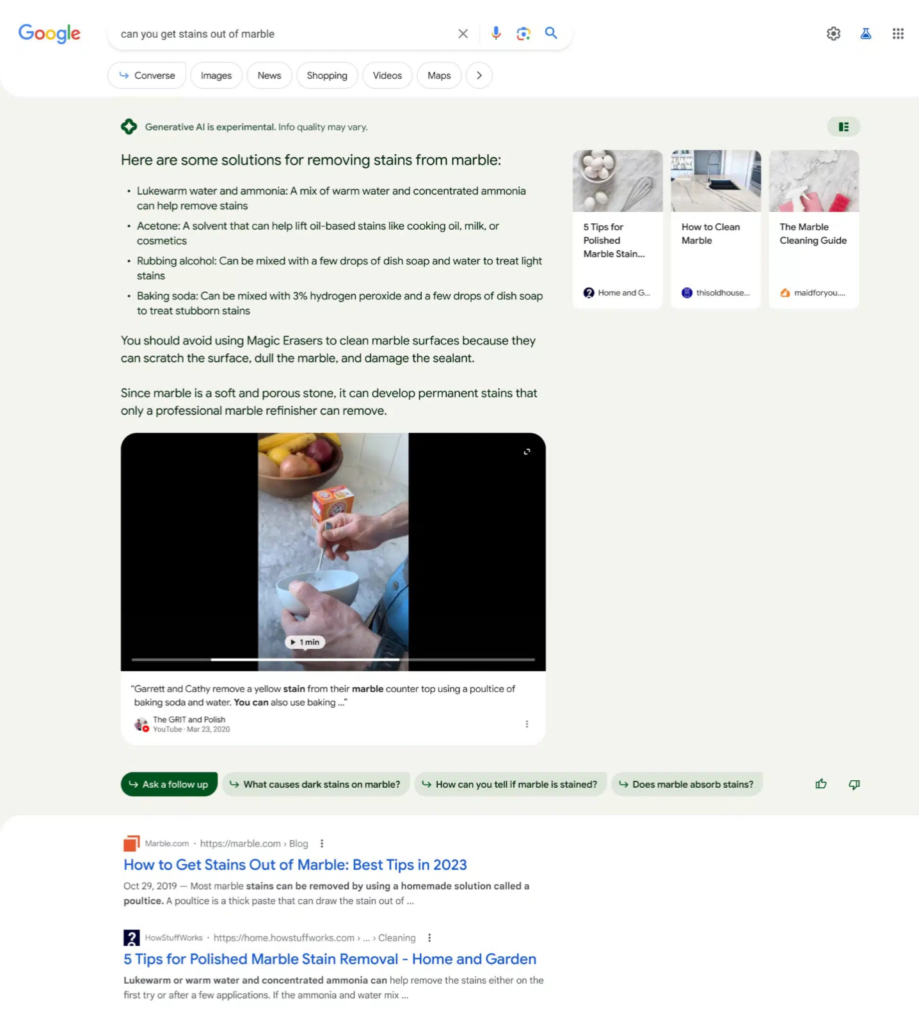When you think about trends, you must ask yourself, are they fluff, or are they here to stay? Think back to the rise of the internet. In 1995, American astronomer and author Clifford Stoll told the world that no online database would replace your daily newspaper. If you were to listen to his advice back then and avoid adopting the new technology, you’d be left behind now. The same is true for trends today. Trends disrupt the market and pave the way for the future, so if you want to get ahead in 2024, read on to find out about the 7 marketing trends you can’t ignore in 2024.
AI Will Be Everywhere
With the public launch of ChatGPT in November 2022 and over one hundred million people using it per week and counting, AI was thrust into the spotlight, and it’s boomed ever since.
Since then, new AI tools have been launched for various parts of business, including AI for SEO, AI for Content Marketing, AI for e-commerce, AI for Customer Service, Sales and more.
And it’s here to stay.
Just like the rise of the internet, there are too many examples to count of business owners shrugging off AI as just another “trend” that’s going to disappear in a year or two.

The thing is, that isn’t the case at all.
In 2024, we expect to see thousands of AI tools battle for market dominance. Many that came out in 2023 may not be around for long. The tools that will win are the ones that integrate smoothly with the platforms we already use. We’ve already seen Google Suite, Canva, Adobe, Zoom, and pretty much every other major player release AI capabilities.
You can expect some smaller tools to be acquired by the big boys — and we will all see AI get significantly more powerful in the year ahead.
There’s no question that AI will fundamentally change many aspects of the work we do. If that makes you feel uncomfortable, you’re not alone. Public opinion is deeply divided, with more and more professionals afraid that AI will take their jobs in the near future.
In reality, the jobless will be those who don’t adopt AI. So, what should you do?
Start learning about AI and start using it for your business, now. Don’t wait until it’s too late.
Don’t know where to start? Here are some resources we recommend getting started with:
- AI for SEO
- AI for e-commerce
- AI for Content Marketing
- Generative AI
- 15 Step AI Framework to Grow Your Blog
2. Generative search and evolving SEO

AI is reshaping traditional search in two significant ways.
- Content Saturation: Tools like ChatGPT and Jasper are simplifying content creation, leading to an influx of written content in an already crowded space. Much of this content is strikingly similar to what already exists. While the concept of content saturation isn’t new, the scale brought about by AI is
- AI-powered generative search: This is revolutionising how you search online. Unlike traditional search engines that return links to ads and pages, generative search produces direct answers to a user’s queries, summarising from its vast training data
In the next year, you can expect generative search to increasingly influence how customers educate themselves and find their way to your business. If you don’t adopt AI to compete in this new market, you’re likely going to fall behind.
However, there are some unknowns.
- The inner workings of ChatGPT or Google’s Generative Search Experience, particularly in how they evaluate and present content, remain largely unknown
- The way these tools will integrate advertising in generative search results is also unclear. Given the trend of increasing ad presence in Google search results, it’s likely generative search will follow a similar path, which means there’s going to be an opportunity to run ads through Generative AI soon. However, how this will work is unknown
Despite these uncertainties, companies are heavily investing in AI’s potential to transform search. If you’re in the SEO or Content Marketing space, you’ll want to make sure you’re using AI and stay on top of these changes as they occur.
3. Short Videos
With the introduction of TikTok and now YouTube Shorts, short video content is going to take over. In fact, it has already taken over.
Platforms will keep prioritising short form or snackable videos, which boost their reach and suit their mobile-first audience. (On YouTube, more than 70% of all traffic is mobile).
HubSpot found most marketers reported short-form video having the best ROI compared to all other media formats.
Maybe you’re thinking, “People may watch a short form video here or there, but it won’t drive actual interest or engagement in my brand.”
You’re wrong. For example, in the last 28 days, we’ve had over 140 hours of watch time on our YouTube channel, most of which is coming from our YouTube Shorts.
Buyers want to get their answers immediately. If you can’t produce educational content in a video that’s less than a minute long, your prospects may turn to your competitors instead who are doing so.
Not sure how to produce a significant amount of short-form content? Check out our guide on how we produce over 65 pieces of content per week.
4. The New Power of Social Media
While social media is not a trend in itself, with the introduction of AI and Generative Search, social media will take on a new meaning for brands moving forward.
AI-generated writing, AI-powered chatbots, and AI video all present great opportunities to get more social media content out with fewer resources. However, they run the risk of alienating audiences with inauthentic content.
As such, consumers will look more and more toward social media for genuine content promising real human connection.
What does this mean for you? It means that while you rely on AI to produce content, you need to make sure you’re humanising your content as well, otherwise you’re going to fail to make a connection with your audience.
5. The Integration of Marketing and Sales
Did you know that on average, today’s buyer has already made 80% of the buying decision BEFORE the first sales call?
Marcus Sheridan, Author of They Ask, You Answer
With the internet now being the predominant point of research for most buyers there is less of a reliance on the sales or customer service department of a business. Buyers have changed, and they will continue to change as technology develops.
On top of that, 43% of B2B customers prefer to not interact with a sales rep at all. And yet, customers expect businesses to provide them with a personalised experience.
So, how can brands achieve this?
The answer is with content and self-service tools (like quizzes, calculators, or a buyer’s guide, for example).
Rather than relying on only the sales team, it should be a combined effort from marketing and sales. Marketing produces content to answer buyer’s most pressing questions, and sales jump on calls with prospects who have already consumed enough of your content to already know what they want.
To serve your modern buyer, your website should provide an experience that’s interactive and customizable so that customers only connect with your sales team when they want to.
6. Interactive Content
A study by Demand Metric and Ion Interactive found that interactive content not only better educates prospective buyers, but also drives twice the conversions and social shares.
Examples of interactive content include quizzes, calculators, and website chatbots. More and more brands are now using interactive content to engage their audience.
Remember, buyers don’t want to talk to sales reps. They want to self-educate, and interactive content is one great way (outside of written articles and video content) that you can do this. If you’ve already built your website learning centre, then the next step might be to jump onto producing interactive content.
Some tools you can get started with immediately to build interactive content are Typeform, Playbuzz, and Riddle.
Depending on which tool you use (or how it’s built), the information gathered through your interactive content can also be saved in your contact database to be used for marketing and sales later on.
7. Helpfulness and Education
Google’s core updates in 2023 have urged creators (once again) to focus on people-first content.
And this is nothing new. Google has always maintained its primary goal is to deliver the best answers to users in the quickest and easiest way — and its move into generative search doubles down on previous updates like featured snippets and “helpful content” algorithm updates.
This is another reminder to marketers that both consumers and search engines are putting more emphasis on the helpfulness of content.
It’s less about SEO optimisation and more about producing helpful and educative content.
Answering yes to the questions below means you’re probably on the right track with a people-first approach:
- If your audience were to come to your website, would they find the content helpful?
- Does your content clearly demonstrate first-hand expertise and a depth of knowledge?
- After reading your content, will someone leave feeling they’ve learned enough about a topic to help achieve their goal?
- Does your content answer your buyer’s most pressing questions?
- Are you being transparent when you produce content for your audience?
To get even more granular, create content that thoroughly and honestly answers questions your buyers are already asking and searching in Google.
The Best 5 Topics to write about are what we call The Big 5, and are:
- Costs: How much your solution costs (and what makes that number go up or down)
- Problems: The negatives about, or issues with, your solution (that buyers tend to ask about)
- Comparisons: How your product or solution compares to similar products or solutions
- Reviews: Honest and unbiased opinions and observations about your product, solution, etc.
- Best: What is the best solution available? I.e. an article reviewing the best competitors in your space.
Studies show these are the topic areas most buyers consider when making any purchase.
These topics and the above trends lay a strong foundation for being seen as a trusted resource and teacher in your space.
So, what’s next?
The digital marketing world is always changing. While you may be able to predict which trends will be here to stay and which won’t, the reality is that no one really knows. The key is that now is the time to start experimenting so you aren’t left behind.
Take these seven trends and slowly incorporate elements of them into your content marketing strategy.
Track their performance and after a few months, you’ll have some data to help you determine which to ditch and which may deliver the benefits and results you’re looking for.
Next, learn how to train ChatGPT to write like you so you can get a better output and differentiate yourself from all the other brands spitting out AI-regurgitated content.













